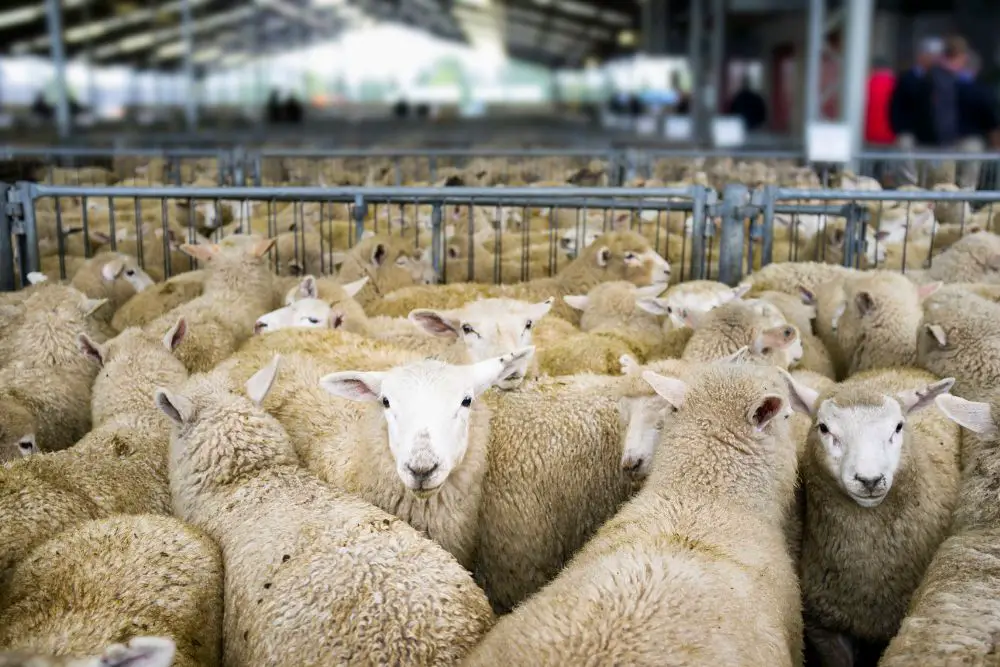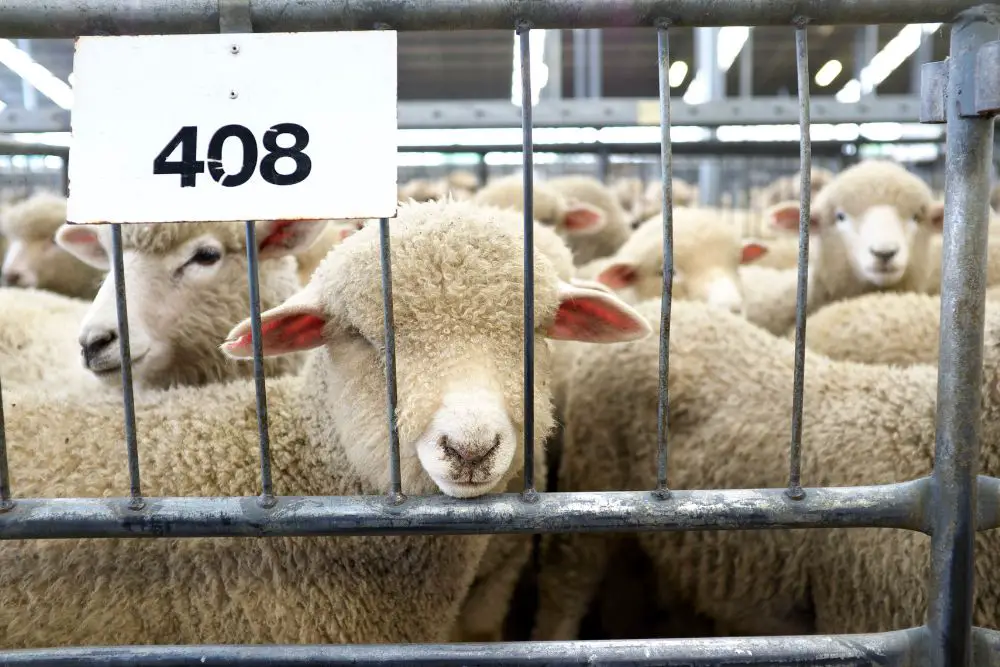Sheep can cost anywhere from $40 for a newborn lamb, right up to $500 for a ram that can produce more offspring. Pricing varies wildly based on breed, age, gender and most importantly: what yields they can bring to the family farm.
Like many commodities, sheep are no exception to fluctuating prices. Many factors determine their buying and selling prices, and numerous ongoing costs surprise first-time farmers.
Table of Contents
Sheep Costs in 2022
The price of a single sheep varies widely depending on many factors, but expect to pay between $40 and $500 USD.
| USD 🇺🇸 | EUR 💶 | British Pounds 🇬🇧 | AUD 🇦🇺 | |
| Rams | $150 to $500 | €145 to €490 | £120 to £410 | $210 to $700 |
| Ewes | $200 to $300 | €195 to €295 | £165 to £250 | $280 to $420 |
| Lambs | $40 to $200 | €39 to €195 | £33 to £165 | $55 to $280 |
Lambs trade for a lower price as they are not at market weight. A lot will depend on the breed, pedigree, and whether you buy from a reputable breeder, or simply the friendly farmer next door.
These are upfront costs to purchase a sheep, without accounting for additional costs such as feed (even with available pasture), shelter, shearing and medical care.
What Determines the Price of a Sheep?
There isn’t a set price for sheep. Even the values listed above are approximations based on current market rates.
Here are several elements that impact sheep pricing:
1. Age and Gender
Generally speaking, rams are worth more than ewes given their ability to produce more sheep in the future for their owners.
While older sheep may be more economical (as they give birth to profitable offspring), adult sheep are nonetheless more expensive than lambs.
A sheep’s remaining productive years decrease with age, with values declining after 5 years due to declining milk and wool production, and thus, become less lucrative than their younger peers.
2. Breed of Sheep
Purebred and certified sheep breeds command the highest prices to sheep farmers, but so too do sheep that produce predictable cash flow for their owners.
Each region has a breed of choice:
| Canada | The heavy lamb market is dominated by Suffolk lambs as they have the highest rate of gain of any breed and adapt well to confinement. |
| South Africa | Dorpers are the choice breed because of their superior feed use and conversion. Since they are so disease resistant, they do not need shearing, crutching, or mulesing. |
| United States | American breeders have bred and chose Suffolk, Dorset and Hampshires to meet the demands of the sheep industry. The ewes are effective milkers and moms, and many births are not unusual. |
| Australia and New ZealandWhile the Merino breed is relatively new to Australia and New Zealand, both countries have accepted this breed with open arms over the last 50 years. They have become the most dominant breed in both countries due to their incredible wool production. |
Generally speaking, the more popular a breed of sheep is, the more affordable it is to purchase as each state will have numerous reputable breeders that will compete for your wallet.
3. Wool and Milk Production
Although all sheep breeds can produce wool, only a few particular breeds can do it on a large enough scale to be commercially profitable. A sheep that produce more wool is typically going to fetch a higher price than those that are only raised for milk or meat, with the exception of certain prolific milk producers such as the East Friesian.
4. Physical and Health
A strong, healthy sheep with good genetics and breeding potential is always preferred, yet not always possible. Some vendors of local farms choose not to divulge the background and genealogy of their sheep, whether by purpose or for simplicity reasons.
It’s not always a red flag when a farmer isn’t perfectly clear about the sheep they’re selling. Some simply have large flocks to manage and having to raise cows, chickens and pigs at the same time.
5. Volume and Transport
Purchasing just 5 sheep of the same breed will be more expensive (per head) than 500 of the same breed. With higher volumes comes larger discounts. This isn’t just reflective of the purchase price but transport home too.

Ongoing Costs
As mentioned previously, the upfront cost of a sheep is only one of the numerous costs you’ll encounter.
Food and Supplements
If you only need to maintain them, your sheep can survive on good quality grass hay 365 days a year. Hay is required to breed more sheep, or simply to get some breeds through the snowy winter months.
100 pounds of hay can cost anywhere from $10 to $50 depending on how much you purchase in bulk and how far it has to travel, with similar costs for grains. In addition, you’ll need to provide salt and access to water troughs.
Shelter
If shelter and fencing will add to your upfront costs if it isn’t already established, and provides protection from both the weather and predators. A small barn is all that’s required. You may also need to purchase a cattle dog, or several, depending on the size of your flock.
Shearing
Shearing is required every year (or even several times a year) for wool breeds.
Shearing equipment can cost anywhere from $300 to $3,000, depending on how many stations in the shearing shed you need fitting out. Some farmers suffer from back pain and choose to outsource this to professional shearers, typically paying $50 to $70 per head.
Veterinary costs
Sheep are generally healthy animals, with the word ‘hardy’ used on many occasions. That said, a vet may need to be called to check for disease, injury, pregnancy, or even to perform a general wellness examination.
A 1-hour consultation costs anywhere from $170 to $450 which includes travel costs. Some breeds will require foot trimming, immunizations and deworming which will add to this cost.
What Are Your Sheep Raising Goals?
Think about what you and your target market desire:
- 90-pound orgnaic lambs raised on pasture?
- Meaty 60-pound roaster lambs finished on grains?
- Plenty of wool to produce socks, blankets and hiking gear?
- Sheep’s milk for those who are lactose intolerant?
Or do you simply want to start showing off sheep at competitions?
These are all quite different sheep-raising objectives, and it all begins with assessing the resources you have, namely capital, time, patience and some prior knowledge.
It’s best to start with a starter flock that can act as your basic breeding stock. Purchase your first flock from a reputable breeder who should be able to answer any question you have. Reputable breeders, as you might assume, aren’t cheap and demand slightly higher prices for their expertise and trust.
Is Keeping Sheep Expensive?
Generally speaking, no. While they can be expensive to purchase upfront, sheep often don’t need barns or sheds, or commercial food like chickens. With good pasture and plenty of space, they’ll typically thrive and will begin providing yields (wool, milk and meat) within 6 months.

